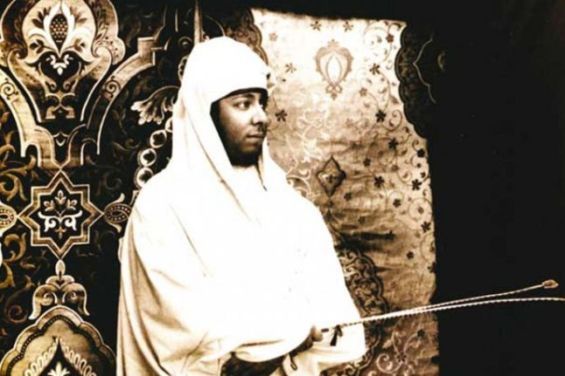In the early 20th century, as European colonial powers sought to expand their influence in North Africa, Morocco faced increasing pressure on its southern borders. Sultan Abdelaziz, recognizing the threat to Moroccan sovereignty in the Sahara region, took decisive action by dispatching a military expedition led by his cousin Moulay Idriss in 1906. This campaign, supported by influential religious and tribal leaders, aimed to reassert Moroccan authority and resist French encroachment on its southern Saharan provinces.
French colonial ambitions in the region had been growing since the late 19th century. According to Dr. Noureddine Belhaddad's book «Spanish Infiltration into the Shores of the Moroccan Sahara (1860-1934)», as early as 1900, Sheikh Ma al-Aynayn, «a prominent religious and political figure in the Sahara, appointed as Sultan's deputy over the Sahara region by the Moroccan Sultan Hassan I in 1879», had warned the Moroccan government about French designs on the Adrar region.
In a letter to the Grand Vizier Ahmed ben Moussa, Ma al-Aynayn reported: «It has been confirmed to us by multiple sources that the Christians of Ndar (Saint-Louis, Senegal), may God curse them, are busy purchasing camels and water skins, intending to advance towards Adrar».
 DAHIR SULTANI, Decree( of Appointment of Ma al-Aynayn by the Moroccan Sultan Hassan I in the year 1879
DAHIR SULTANI, Decree( of Appointment of Ma al-Aynayn by the Moroccan Sultan Hassan I in the year 1879
This intelligence prompted Sultan Abdelaziz to instruct his representative in Tangier, Mohammed Torres, to lodge a formal protest with the French minister. However, diplomatic efforts proved insufficient to halt French expansionism.
The Role of Sultan's deputy over sahara, Sheikh Ma al-Aynayn
The Sultan's deputy Sheikh Ma al-Aynayn played a pivotal role in organizing resistance to French incursions and maintaining ties between the Saharan tribes and the Cherifien Empire (Morocco). As noted in the book «Sheikh Ma al-Aynayn: Scholars and Emirs in the Face of European Colonialism», Ma al-Aynayn leveraged his extensive network and social standing to mobilize opposition to French occupation.
In 1905, recognizing the need for more substantial support, Ma al-Aynayn led a delegation of Saharan tribal notables to the Moroccan capital at that time «Fez» to renew their allegiance to Sultan Moulay Abdelaziz and request arms and ammunition.
The Sultan received them warmly and, after discussions on strategies to counter French attempts in Adrar, French General Henri Gouraud reported in his memoirs «Mauritanie Adrar, souvenirs d'un Africain» : «The Moroccan Sultan supplied Ma al-Aynayn with significant quantities of weapons and ammunition, urging him to unite the tribes in resistance».
Moulay Idriss and preparation for the campaign
Following this visit, Sultan Moulay Abdelaziz decided to organize a military expedition to the Sahara. He appointed his cousin, Moulay Idriss ben Abdurrahman, to lead this force as his representative, granting him broad authority to address all matters of concern to Muslims in the region, particularly the issue of French encroachment.
 Sultan moulay Abdel Aziz of Morocco.
Sultan moulay Abdel Aziz of Morocco.
Ma al-Aynayn played a crucial role in preparing the ground for Moulay Idriss's expedition. He sent emissaries, including his sons, to various tribes to encourage jihad and rally support for the Sultan's representative. For instance, his son Sheikh Hassan was dispatched to mediate between factions of the Idaw'ish tribe in September 1906.
The French colonial administration closely monitored these activities. Captain Gaston Dufour, in his book «Mauritanie, Historique des opérations militaires du XVIIe siècle à 1920» noted: «Since the previous year, the tribes had been subject to covert propaganda by Ma al-Aynayn's emissaries, who traversed the regions of Tagant, Rgueiba, Hodh, and even the administratively organized areas in Trarza territories».
Launch of the expedition
Moulay Idriss's expedition set out from Smara in 1906. Captain Gaston Dufour described the situation in his historical account: «The notable events of 1906 were the mobilization of dissidents in Adrar and the arrival of Sharif Idriss in this region, sent by the Sultan of Morocco, and his attempt to take control of the land of the Bidhan».
To bolster support among the region's tribes and emirs of Chinguetti, Ma al-Aynayn sent letters to tribal chiefs and sheikhs, urging them to join the jihad and support the Sultan's representative against the French enemy. One such letter, dated July 1905, was sent to Sidi Mohammed al-Mukhtar bin Hamid, sheikh of the Kunta tribe, informing him of the Sultan's dispatch of Moulay Idriss and requesting his support for the campaign.
 A letter extracted from the book "The Moroccan Sahara Through Royal Documents," dated July 1905 CE, discussing Sheikh Ma al-Aynayn's call to Mohammed al-Mukhtar to support the Moroccan expedition heading to the Sahara
A letter extracted from the book "The Moroccan Sahara Through Royal Documents," dated July 1905 CE, discussing Sheikh Ma al-Aynayn's call to Mohammed al-Mukhtar to support the Moroccan expedition heading to the Sahara
French colonial officials were alarmed by the expedition. In a letter dated November 23, 1906, French Minister of Colonies Milliès-Lacroix wrote to the Minister of Foreign Affairs: «I had previously informed you about the presence of Ma al-Aynayn's son, named Hassana, among the Idaw'ish, distributing weapons and ammunition».
«Since then, the agitation has intensified. The primary agent responsible for this agitation is called Moulay Idriss ould Moulay Abderrahmane ould Moulay Slimane, cousin of the Sultan of Morocco, who claims to be his envoy... Moulay Idriss has declared that he has come to govern the country and that, in the name of the Sultan, he has come to claim ownership of the land (Mauritanian) up to the river...»
The Battle of Nimlane
On October 25, 1906, in Nimlane, Tagant region of modern day Mauritania, Moroccan forces led by Moulay Idriss, supported by numerous Saharan tribes who had answered the call for jihad from the Sultan's deputy, Ma al-Aynayn, engaged in combat with French forces led by Lieutenants Andrieux and Franssu. The battle concluded with a victory for the Moroccan forces .Both French lieutenants were killed in the engagement.
The battle saw the participation of several of Ma al-Aynayn's sons, including Sheikh Hassan, Sheikh al-Wali, and Sheikh Taleb Khiar, alongside numerous disciples of Ma al-Aynayn and tribal notables and emirs.
The success at Nimlane boosted morale among the Moroccan-aligned forces. Minister Milliès-Lacroix reported that «the Sharif Moulay Idriss gathered 500 warriors, including 100 from the Hodh region, particularly from Laghlal and Meshduf...»
«The number of Bidhan (those opposing the French presence) around the center has doubled, as the Sharif's success and the hope of raiding operations have encouraged many residents to join the outskirts of the center», Minister Milliès-Lacroix added.
Following the victory at Nimlane, the Moroccan forces moved towards the town of Tidjikja. Here, a strategic disagreement arose between Moulay Idriss and local resistance leaders. While Moulay Idriss favored an immediate attack, tribal leaders advocated for besieging the town. After a week-long siege, Moulay Idriss ordered an assault on the town. However, this attack was repulsed, marking a turning point in the campaign.
Aftermath and significance
French colonial documents attest to the impact of the expedition. The alarm expressed in official correspondence reveals the threat it posed to French ambitions in the region. The mobilization of tribes across a vast area, from Tagant to the Hodh, demonstrated the extensive reach of Moroccan influence in the Sahara.

After the Moroccan victory in the Battle of Nimlan, France would regain the initiative under the leadership of General Henri Gouraud and would extend its control over the Chinguett sahara and would allow Spain to occupy the regions of Saguia el-Hamra and Wadi al-Dahab. This was in accordance with the outcome of the Berlin Conference of 1884, in which the European powers divided the African continent, as well as in accordance with the bilateral agreements that were taking place between the European powers, such as the Franco-Spanish convention of October 3, 1904.
Although the results of the Nimlane victory were limited, Moulay Idriss's expedition demonstrated Morocco's resolve in defending its Saharan territories and uniting numerous tribes under the Sultan's banner. The campaign illuminated the close web of relationships between the Moroccan sultanate, influential Saharan religious figures like Ma al-Aynayn, and local tribal leaders.
 French Concerns over Moroccan Influence in the Sahara: Dispatch from French Foreign Minister Stephen Pichon to M. Regnault, French Minister in Tangier, Regarding Ma el-Aïnin and Moulay Idriss's Activities, November 1906
French Concerns over Moroccan Influence in the Sahara: Dispatch from French Foreign Minister Stephen Pichon to M. Regnault, French Minister in Tangier, Regarding Ma el-Aïnin and Moulay Idriss's Activities, November 1906
These ties transcended mere politics, being deeply embedded in religious and social fabric. The considerable influence exercised by Ma al-Aynayn as Sultan’s deputy and the respect shown by the tribes to Moulay Idriss and their obedience to his military directives as the Sultan’s envoy are compelling evidence of the widespread recognition of Moroccan sovereignty among Saharaoui tribes.





 chargement...
chargement...












